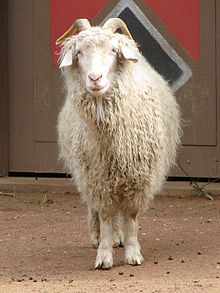Angora goat
 | |
| Conservation status | |
|---|---|
| Other names |
|
| Country of origin | Turkey |
| Distribution | world-wide |
| Use | |
| Traits | |
| Weight | |
| Height | |
| Wool colour | usually white, also black, brown or grey |
| |
The Angora or Ankara[a] is a Turkish breed of domesticated goat. It produces the lustrous fibre known as mohair. It is widespread in many countries of the world. Many breeds derive from it, among them the , the , the of the Russian Federation and the Pygora in the United States.[4]: 358
History[]

The origin of the Angora is not known.[5]: 73 The earliest Western description may be that published in 1555 by Pierre Belon,[6]: 12 who while travelling from Heraclea to Konya in southern Turkey had seen goats with snow-white "... wool so delicate that one would judge it finer than silk ...".[7]: 296r
Angora goats were depicted on the reverse of the Turkish 50 lira banknotes of 1938–1952.[8]
The first Angora goats were brought to Europe by Charles V, Holy Roman Emperor, about 1554, but, like later imports, were not very successful.[citation needed]
In 1960 there were over 6 million Angora goats in Turkey; the population subsequently dropped sharply.[4]: 357 In 2004 the total goat population of the country was approximately 7.2 million; of these, just over 5% were of Angora stock, while the remainder were hair goats.[9]: 21 A for the Angora was established in 2003.[4]: 357
Characteristics[]

The Angora is a moderately small goat, standing about 50–55 cm at the withers.[4]: 357 It is slender, elegant and light-framed;[3] the head is small, with semi-lop ears. It is usually horned; in billies the horns are commonly twisted, long and strong.[4]: 357 With the exception of the face and legs, the animal is entirely covered in a coat of long ringlets of fine and lustrous mohair.[3] This is not goat hair as seen on other breeds, but the down or undercoat which, in this breed only, grows much longer than the outer hair coat. The face and coat are normally white, but – particularly in southern Turkey – black, brown and grey animals also occur.[4]: 357
Use[]
The fleece taken from an Angora goat is called mohair. A single goat produces between four and five kilograms of hair per year. Angoras are shorn twice a year.
Turkey, Argentina, the United States, and South Africa are the top producers of mohair.[10]
See also[]
Notes[]
References[]
| Wikimedia Commons has media related to Angora goat. |
- ^ Barbara Rischkowsky, Dafydd Pilling (editors) (2007). List of breeds documented in the Global Databank for Animal Genetic Resources, annex to The State of the World's Animal Genetic Resources for Food and Agriculture. Rome: Commission on Genetic Resources for Food and Agriculture, Food and Agriculture Organization of the United Nations. ISBN 9789251057629. Archived 23 June 2020.
- ^ Transboundary breed summary: Goat / Angora. Domestic Animal Diversity Information System of the Food and Agriculture Organization of the United Nations. Accessed July 2021.
- ^ Jump up to: a b c d e f Breed data sheet: Ankara / Turkey (Goat). Domestic Animal Diversity Information System of the Food and Agriculture Organization of the United Nations. Accessed July 2021.
- ^ Jump up to: a b c d e f g Valerie Porter, Lawrence Alderson, Stephen J.G. Hall, D. Phillip Sponenberg (2016). Mason's World Encyclopedia of Livestock Breeds and Breeding (sixth edition). Wallingford: CABI. ISBN 9781780647944.
- ^ Lawrance Hunter, E.L. Hunter (2001). Mohair. In: Robert R. Franck (editor) (2001). Silk, Mohair, Cashmere and Other Luxury Fibres. Cambridge: Woodhead Publishing. ISBN 9781855735408, pages 68–132.
- ^ John L. Hayes (1868). The Angora Goat: Its Origin, Culture and Products. Boston: Museum of the Boston Society of Natural History.
- ^ Pierre Belon (1555). Les Observations de plusieurs singularitez et choses mémorables trouvées en Grèce, Asie, Judée, Égypte, Arabie et autres pays estranges, rédigées en trois livres, par Pierre Belon (in French). Anvers: chez Iean Steelsius à l'escu de Bourgoigne. "Les Cheures de ce pays portent la laine si deliée, qu'on la iugeroit estre plus fine que soye; aussi surpasse elle la neige en blancheur".
- ^ Central Bank of the Republic of Turkey Archived 2009-06-03 at WebCite. Banknote Museum:
2. Emission Group – Fifty Turkish Lira – I. Series Archived 2009-02-25 at the Wayback Machine;
3. Emission Group – Fifty Turkish Lira – I. Series Archived 2008-12-25 at the Wayback Machine & II. Series Archived 2007-09-12 at the Wayback Machine . – Retrieved on 20 April 2009. - ^ [s.n.] (2004). Turkey: Country Report on Farm Animal Genetic Resources. Ankara. Annex to: Barbara Rischkowsky, Dafydd Pilling (editors) (2007). The State of the World's Animal Genetic Resources for Food and Agriculture. Rome: Commission on Genetic Resources for Food and Agriculture, Food and Agriculture Organization of the United Nations. ISBN 9789251057629. Archived 10 January 2017.
- ^ "South African Department of Agriculture, Forestry & Fisheries, 2011" (PDF). Retrieved 2018-03-24.
- Goat breeds
- Fiber-producing goat breeds
- Goat breeds originating in Turkey